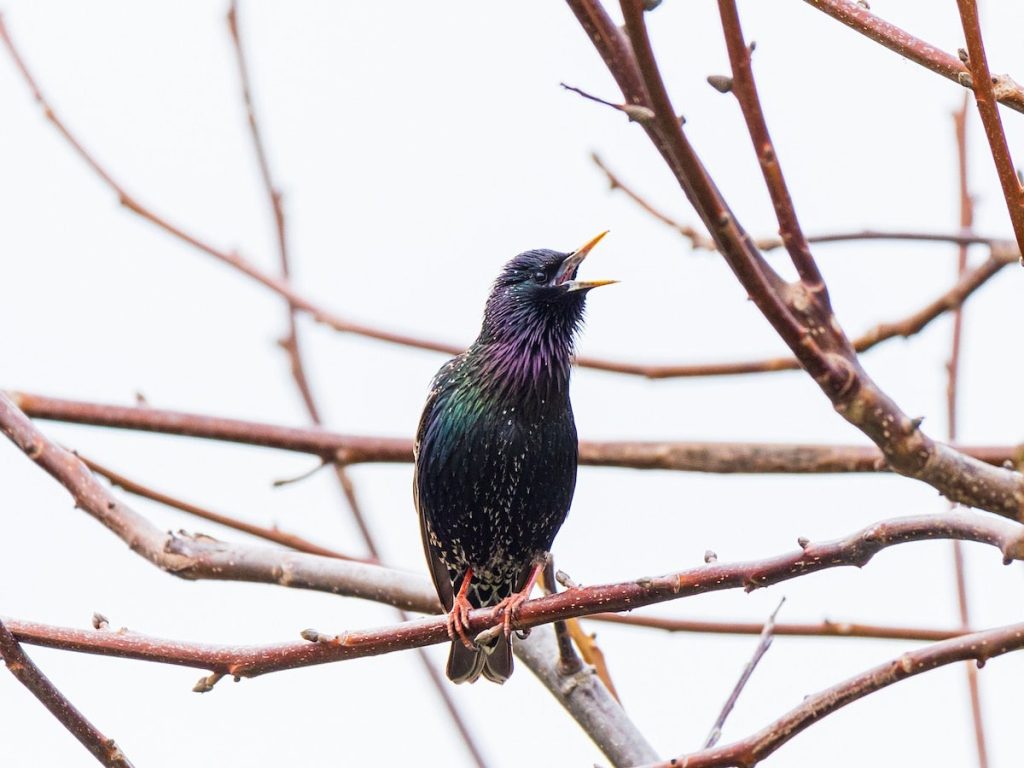Superior Vocal Learning in Birds Linked to Better Problem Solving and Bigger Brain Size
4 min read
A European starling perched on a twig and singing. TorriPhoto / Moment / Getty Images
Founded in 2005 as an Ohio-based environmental newspaper, EcoWatch is a digital platform dedicated to publishing quality, science-based content on environmental issues, causes, and solutions.
Originally introduced to North America in the 1800s, the European starling is a magnificent bird, tawny brown with white spots in winter, shining with iridescent purple and green feathers in summer.
Not only are they dazzling, since starlings are also some of the most skilled vocal learners, with the ability to mimic the calls of as many as 20 other species, according to Cornell University’s All About Birds.
Starlings learn an impressive variety of calls, warbles, whistles and songs during their lifetimes, a press release from The Rockefeller University said. Besides being superior vocal learners, a new study has revealed that these remarkable birds are also exceptional at problem solving.
“There is a long-standing hypothesis that only the most intelligent animals are capable of complex vocal learning,” said Jean-Nicolas Audet, co-author of the study and a research associate in the laboratory of Erich Jarvis at The Rockefeller University, in the press release. “If that is true, then complex vocal learners should also be better at cognitive tasks, but no one had ever demonstrated that before.”
Complex vocal learning is defined as having the skill to learn and remember a large variety of sounds. Only a small number of animal groups are able to do this, including whales, seals, elephants, bats, humans, parrots, songbirds and hummingbirds.
The research team focused on songbirds, ranking the complexity of their vocal learning using three metrics: whether or not the bird was able to learn new calls and songs through their lifetime, how many calls and songs were in their repertoire and if they were able to mimic other species.
The study, “Songbird species that display more-complex vocal learning are better problem-solvers and have larger brains,” was published in the journal Science.
The researchers spent three years capturing hundreds of wild birds covering 21 species at The Rockefeller University Field Research Center, located on 1,200 acres of protected land that is home to a wide variety of ecosystems in the Hudson Valley.
“It’s a protected area, which means the animals have limited exposure to humans,” said Mélanie Couture, a research assistant who co-authored the study, in the press release. “This is ideal for studying the behaviors of wild birds — what they can do, and how they react to cognitive tasks.”
There were just three types of birds that were able to mimic other species, which Audet said is “the epitome of vocal learning.” They were blue jays, gray catbirds, who are related to mockingbirds, and starlings. The research team ranked these three highest in vocal learning capability.
The team conducted a series of cognitive evaluations on 214 birds of 23 species, including two that had been raised in a lab. The researchers looked at their ability to problem solve by challenging them to pull a stick, pierce foil or remove a lid in order to get to a treat. They also tested for self-control and learning associated with color.
The research team found a strong connection between vocal learning aptitude and problem-solving abilities. Bluejays, starlings and gray catbirds were the best at problem solving, as well as the most adept vocal learners. And birds who were best at navigating around obstacles in order to get to a treat also had more advanced vocal learning ability.
The research team also discovered that birds who were highly skilled problem solvers and vocal learners had larger brains in relation to body size.
“Our next step is to look at the brains of the most complex species and try to understand why they are better at problem solving and vocal learning,” Audet said in the press release. “We have a pretty good idea of where vocal learning happens in the brain, but it’s not yet clear where problem solving occurs.”
The findings of the study suggest that the evolution of problem solving, vocal learning and brain size may have occurred together, possibly in order to boost biological fitness. Jarvis has termed the collection of traits — based on the study’s findings and previous work that assessed how well vocal learners could dance to a beat — the “vocal learning cognitive complex.”
“Our findings help support a previously unproven notion: that the evolution of a complex behavior like spoken language, which depends on vocal learning, is associated with co-evolution of other complex behaviors,” Jarvis said in the press release.
Subscribe to get exclusive updates in our daily newsletter!
By signing up, you agree to the Terms of Use and Privacy Policy & to receive electronic communications from EcoWatch Media Group, which may include marketing promotions, advertisements and sponsored content.





